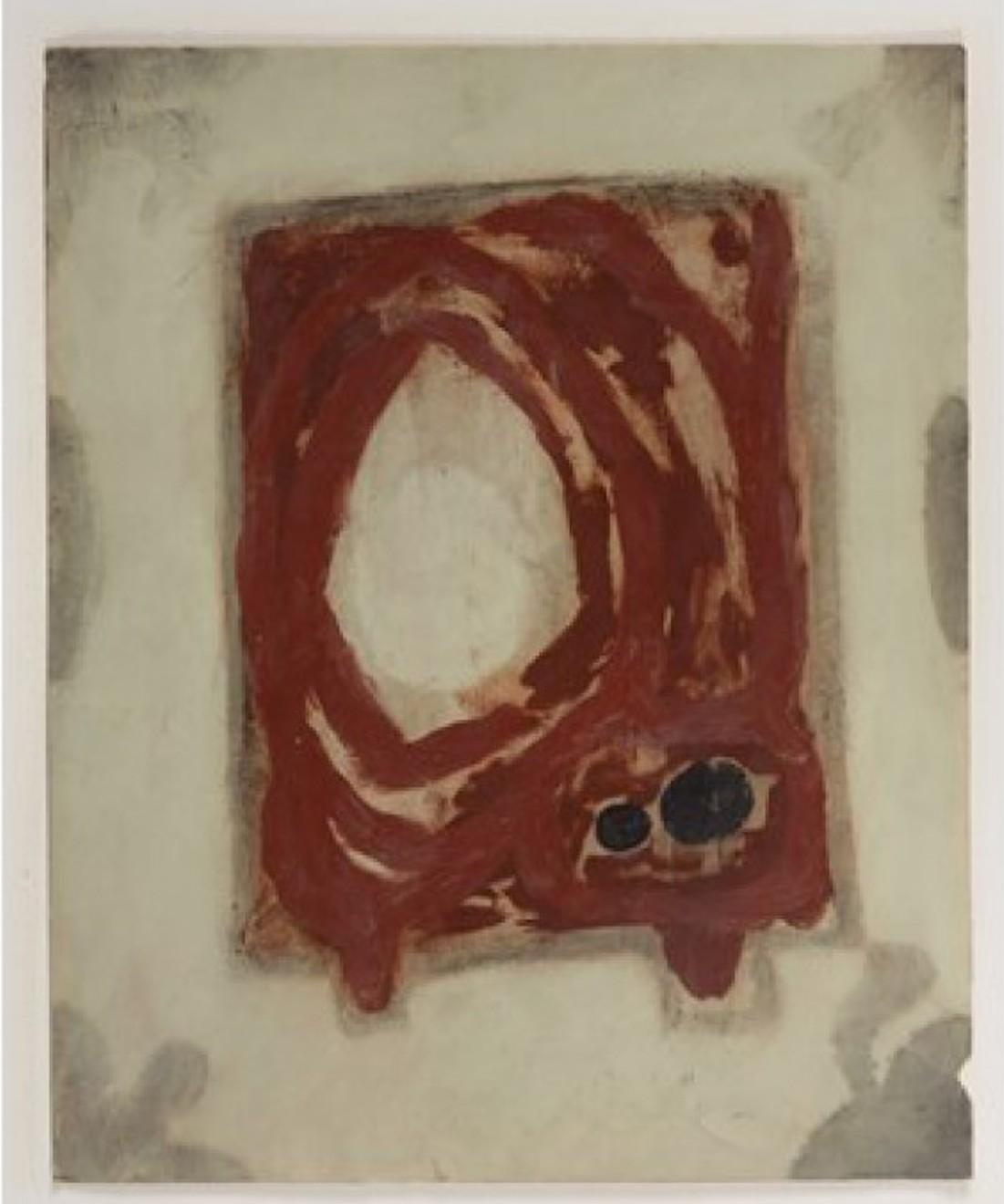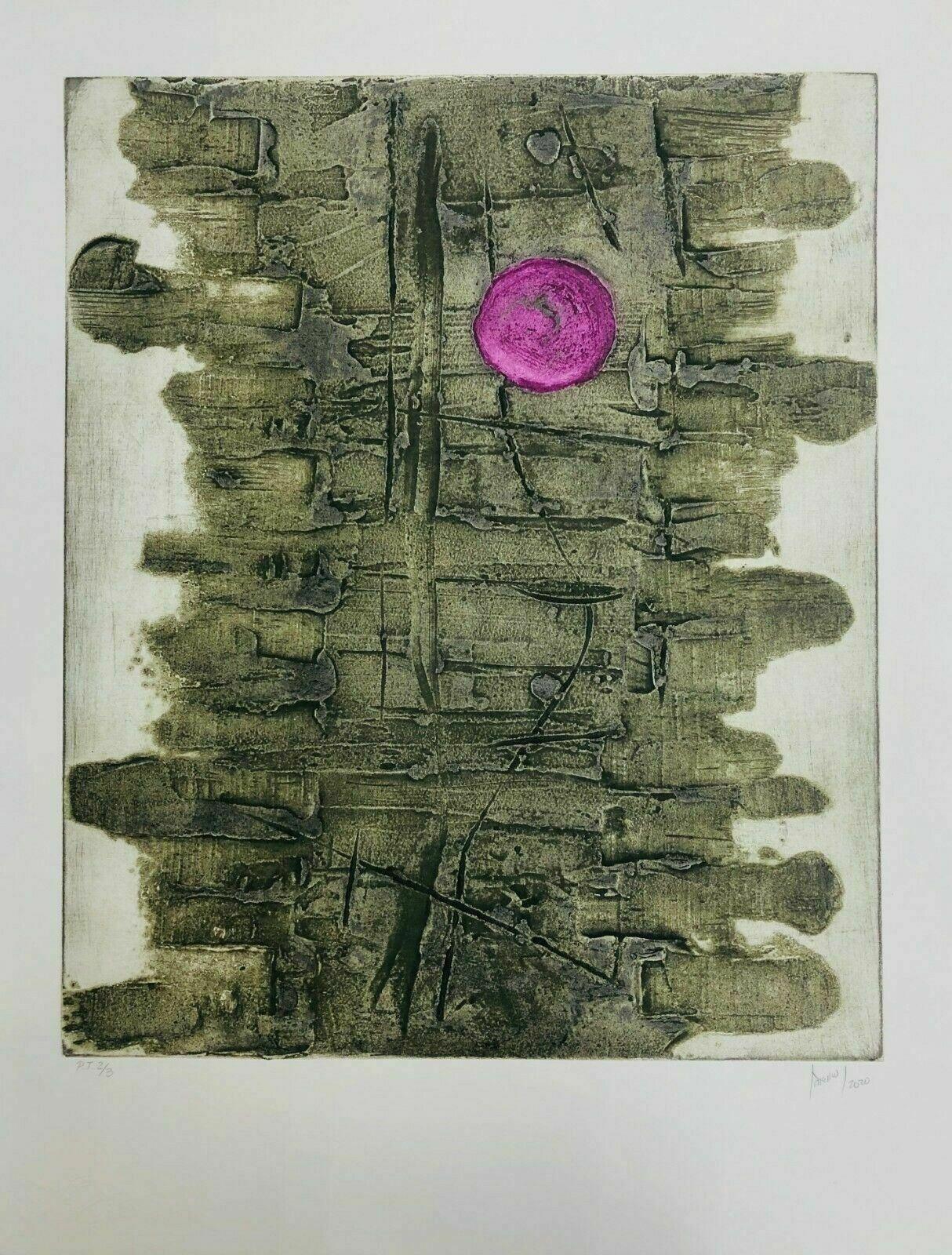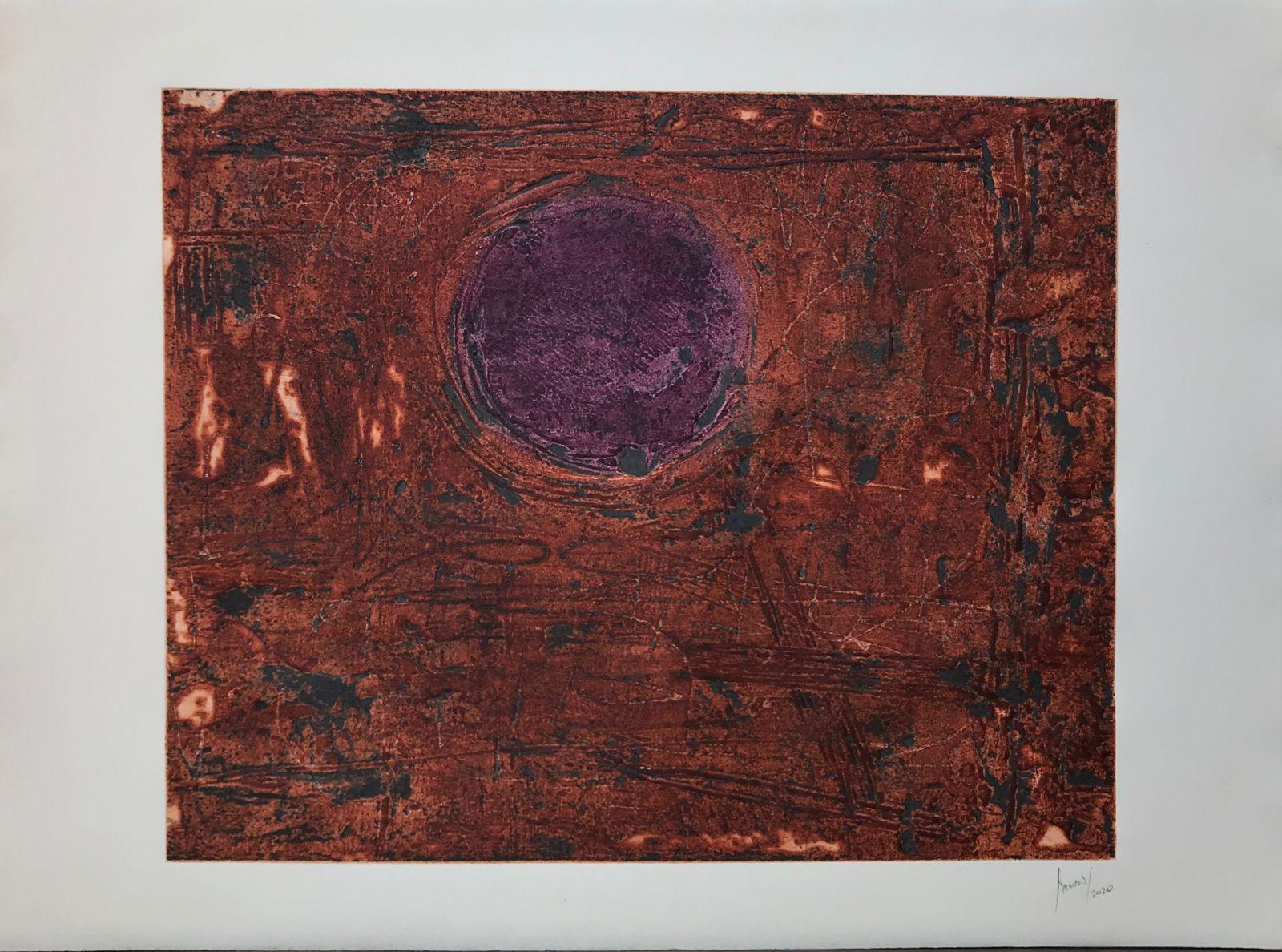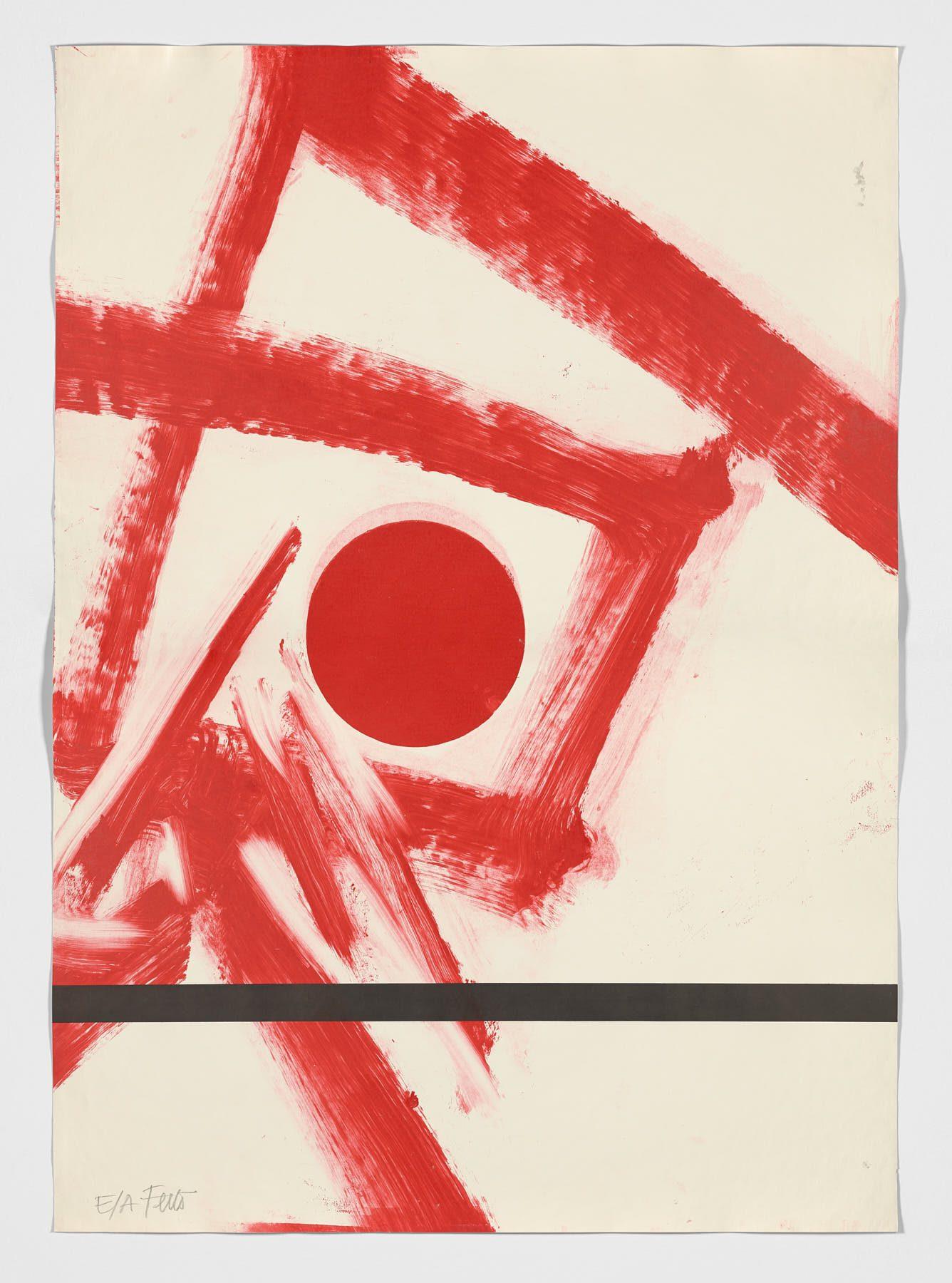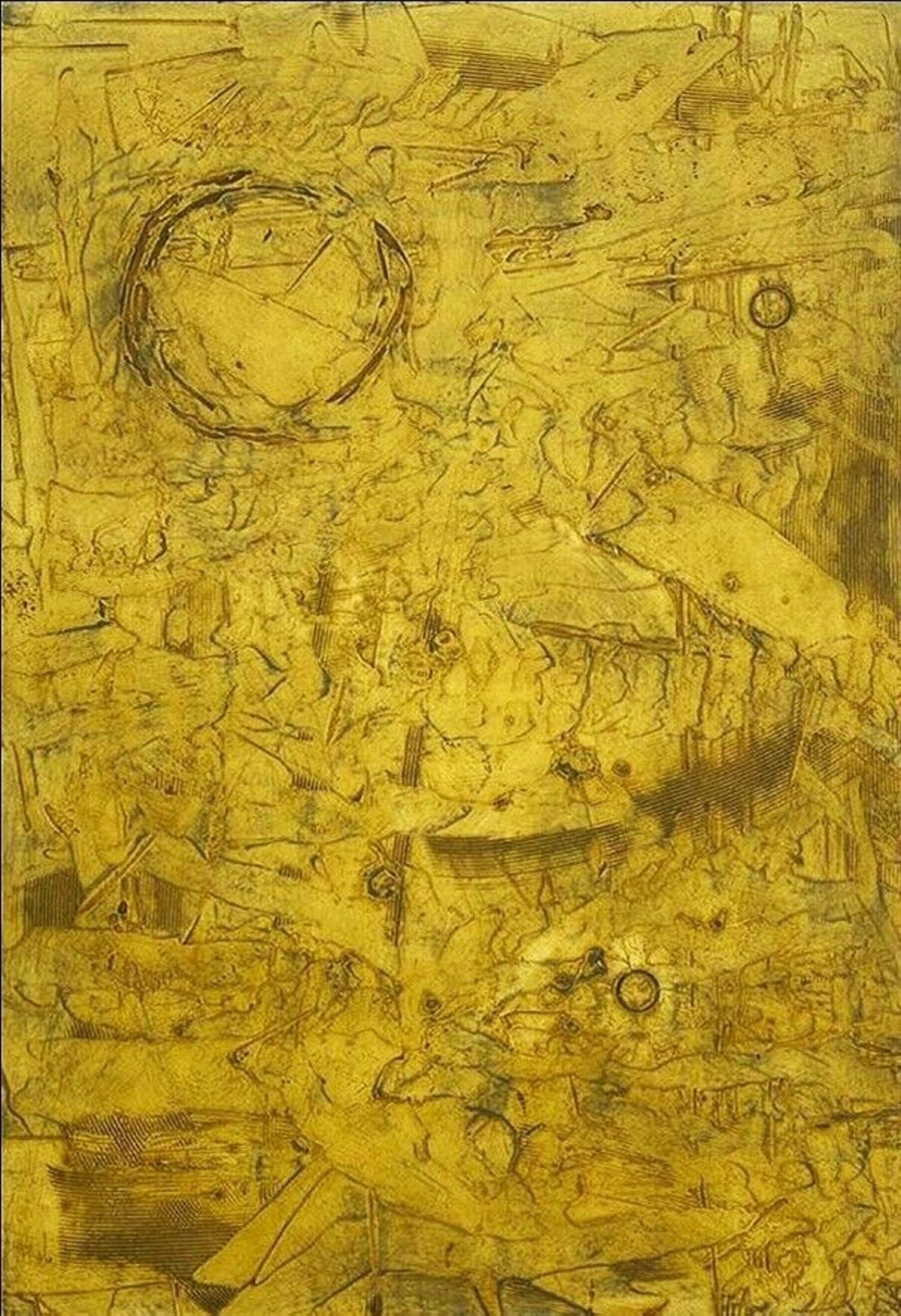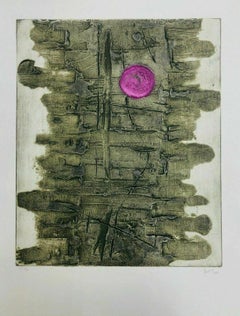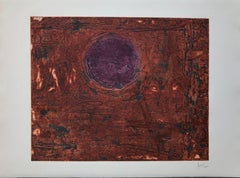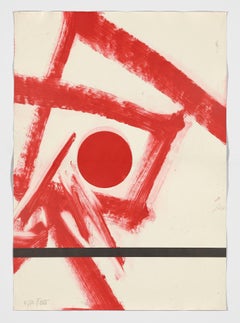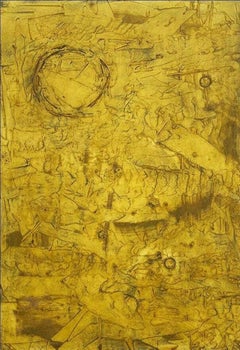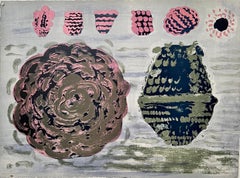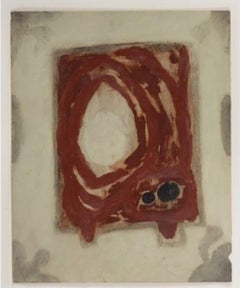Items Similar to Miguel Rasero Spanish Artist Original Hand Signed carborundum, chine colle
Want more images or videos?
Request additional images or videos from the seller
1 of 4
Miguel RaseroMiguel Rasero Spanish Artist Original Hand Signed carborundum, chine colleN/A
N/A
$1,700
£1,283.77
€1,469.80
CA$2,400.84
A$2,621.15
CHF 1,374.16
MX$31,834.84
NOK 17,161.03
SEK 16,204.58
DKK 10,970.50
About the Item
Miguel Rasero (Spain, 1955)
'Vinas', N/A
carborundum, chine colle on Heavy weight handmade paper
52.6 x 40.6 in. (133.5 x 103 cm.)
Edition of 18
ID: RAS-301
Hand-signed by author
- Creator:Miguel Rasero (1955, Spanish)
- Creation Year:N/A
- Dimensions:Height: 52.6 in (133.61 cm)Width: 40.6 in (103.13 cm)
- Medium:
- Movement & Style:
- Period:
- Condition:The edges are a bit battered.
- Gallery Location:Miami, FL
- Reference Number:1stDibs: LU1854212443572
About the Seller
5.0
Vetted Professional Seller
Every seller passes strict standards for authenticity and reliability
Established in 2000
1stDibs seller since 2022
105 sales on 1stDibs
- ShippingRetrieving quote...Shipping from: Miami, FL
- Return Policy
Authenticity Guarantee
In the unlikely event there’s an issue with an item’s authenticity, contact us within 1 year for a full refund. DetailsMoney-Back Guarantee
If your item is not as described, is damaged in transit, or does not arrive, contact us within 7 days for a full refund. Details24-Hour Cancellation
You have a 24-hour grace period in which to reconsider your purchase, with no questions asked.Vetted Professional Sellers
Our world-class sellers must adhere to strict standards for service and quality, maintaining the integrity of our listings.Price-Match Guarantee
If you find that a seller listed the same item for a lower price elsewhere, we’ll match it.Trusted Global Delivery
Our best-in-class carrier network provides specialized shipping options worldwide, including custom delivery.More From This Seller
View AllAdan Paredes, ¨Untitled¨, 2020, Collagraph, 28.3x22 in
Located in Miami, FL
Adan Paredes (Mexico, 1961)
'Untitled 2', 2020
collagraph on paper Feltmark 300 g
28.4 x 22.1 in. (72 x 56 cm.)
Edition of 40
ID: PAD-102
Unframed
Category
2010s Contemporary Prints and Multiples
Materials
Paper, Ink, Etching, Screen
Adan Paredes, ¨Untitled¨, 2020, Collagraph, 22x29.9 in
Located in Miami, FL
Adan Paredes (Mexico, 1961)
'Untitled 10', 2020
collagraph on paper Guarro Super Alpha 250g.
22.1 x 26.6 in. (56 x 67.5 cm.)
Unframed
ID: PAD-110
Hand-signed by author
Category
2010s Contemporary Prints and Multiples
Materials
Paper, Ink, Etching, Screen
Spanish Artist signed limited edition original art print intagio monotype n63
By Luis Feito López
Located in Miami, FL
Luis Feito (Spain, 1929-2021)
'Guadarrama V', 2004
intaglio monotype on paper
55.2 x 39.4 in. (140 x 100 cm.)
Edition of 76
Unframed
ID: FEI1051-063
Hand-signed by author
Category
Early 2000s Abstract Prints and Multiples
Materials
Paper, Intaglio, Monotype
Adan Paredes, ¨Untitled¨, 2020, Collagraph, 42.5x29.1 in
Located in Miami, FL
Adan Paredes (Mexico, 1961)
'Untitled 5', 2020
collagraph on paper
42.6 x 29.2 in. (108 x 74 cm.)
Edition of 40
ID: PAD-105
Unframed
Category
2010s Contemporary Prints and Multiples
Materials
Paper, Ink, Etching, Screen
Adan Paredes, ¨Untitled¨, 2020, Collagraph, 42.5x29.1 in
Located in Miami, FL
Adan Paredes (Mexico, 1961)
'Untitled 7', 2020
collagraph on paper Feltmark 300 g
42.6 x 29.2 in. (108 x 74 cm.)
Edition of 40
ID: PAD-107
Unframed
Category
2010s Contemporary Prints and Multiples
Materials
Paper, Ink, Etching, Screen
Irineu Garcia, ¨Animal del viento homenagem a¨ 2009 Carborundum 20.9x27.8 in
Located in Miami, FL
Irineu Garcia (Brazil, 1946)
'Animal del viento homenagem a', 2009
engraving, carborundum on paper Guarro Biblos 250g.
20.9 x 27.8 in. (53 x 70.5 cm.)
Edition of 25
Unframed
ID: GAR-...
Category
Early 2000s Contemporary Abstract Prints
Materials
Paper, Screen, Etching
You May Also Like
Pietro Consagra Italian Mod Abstract Expressionist Forma Art Informel Lithograph
By Pietro Consagra
Located in Surfside, FL
Pietro Consagra (Italian, 1920-2005).
Hand signed in pencil and numbered limited edition color lithograph on Magnani paper.
Embossed stamp with limited edition numbers in pencil to lower left, and having artist pencil signature to lower right.
(from a limited edition of 80 with 15 artist's proofs)
Published by Stamperia 2RC, Rome Italy and Marlborough Gallery, Rome, Italy.
Abstract Modernist work in colors, produced in the style of the Forma art movement of Postwar Italy, of which the artist was a prominent member.
Pietro Consagra (1920 – 2005) was an Italian Post war artist working in painting, printmaking and sculpture. In 1947 he was among the founding members of the Forma 1 group of artists, proponents of structured abstraction. (similar to the Art Informel and Art Brut in France and the Brutalist artists)
Consagra was born on 6 October 1920 in Mazara del Vallo, in the province of Trapani in south-western Sicily, to Luigi Consagra and Maria Lentini. From 1931 he enrolled in a trade school for sailors, studying first to become a mechanic, and later to become a captain. In 1938 he moved to Palermo, where he enrolled in the liceo artistico; despite an attack of tuberculosis, he graduated in 1941, and in the same year signed up at the Accademia di Belle Arti, where he studied sculpture under Archimede Campini. After the Invasion of Sicily and the Allied occupation of Palermo in 1943, Consagra found work as a caricaturist for the American Red Cross club of the city; he also joined the Italian Communist Party. Early in 1944, armed with a letter of introduction from an American officer, he travelled to Rome. There he came into contact with the Sicilian artist Concetto Maugeri, and through him with Renato Guttuso, who was also Sicilian and who introduced him to the intellectual life of the city and to other postwar artists such as Leoncillo Leonardi, Mario Mafai and Giulio Turcato. Consagra signed up at the Accademia di Belle Arti di Roma in September 1944 and studied sculpture there under Michele Guerrisi, but left before completing his diploma.
In 1947, with Carla Accardi, Ugo Attardi, Piero Dorazio, Mino Guerrini, Achille Perilli, Antonio Sanfilippo and Giulio Turcato, Consagra started the artist's group Forma 1, which advocated both Marxism and structured abstraction.
Steadily Consagra's work began to find an audience. Working primarily in metal, and later in marble and wood, his thin, roughly carved reliefs, began to be collected by Peggy Guggenheim and other important patrons of the arts. He showed at the Venice Biennale eleven times between 1950 and 1993, and in 1960 won the sculpture prize at the exhibition. During the 1960s he was associated with the Continuità group, an offshoot of Forma I, and in 1967 taught at the School of Arts in Minneapolis. Large commissions allowed him to begin working on a more monumental scale, and works of his were installed in the courtyard of the Foreign Ministry in Rome and in the European Parliament, Strasbourg. His work is found in the collections of The Tate Gallery, London, in Museo Cantonale d'Arte of Lugano and the Museum of Modern Art, Paris, and the National Gallery of Art in Washington, D.C..
Consagra returned to Sicily where he sculpted a number of significant works during the 1980s. With Senator Ludovico Corrao, he helped created an open-air museum in the new town of Gibellina, after the older town had been destroyed in the earthquake of 1968. Consagra designed the gates to the town's entrance, the building named "Meeting" and the gates to the cemetery, where he was later buried.
In 1952 Consagra published La necessità della scultura ("the need for sculpture"), a response to the essay La scultura lingua morta ("sculpture, a dead language"), published in 1945 by Arturo Martini. Other works include L'agguato c'è ("the snare exists", 1960), and La città frontale ("the frontal city", 1969). His autobiography, Vita Mia, was published by Feltrinelli in 1980. In 1989 a substantial retrospective exhibition of work by Consagra was shown at the Galleria Nazionale d'Arte Moderna in Rome; in 1993 a permanent exhibition of his work was installed there. In 1991 his work was shown in the Hermitage Museum in St. Petersburg. In 2002 the Galerie der Stadt Stuttgart opened a permanent exhibition of his work. He was one of ten artists invited by Giovanni Carandente, along with David Smith, Alexander Calder, Arnaldo Pomodoro, Lynn Chadwick, and Beverly Pepper, to fabricate works in Italsider factories in Italy for an outdoor exhibition, "Sculture nella città", held in Spoleto during the summer of 1962. He was included in the The 1962 International Prize for Sculpture the jury included Argan, Romero Brest and James Johnson Sweeney the former director of the Solomon R. Guggenheim Museum in New York. The participants included Louise Nevelson and John Chamberlain for the United States; Lygia Clark for Brazil; Pietro Consagra, Lucio Fontana, Nino Franchina, and Gió Pomodoro for Italy; Pablo Serrano for Spain; and Eduardo Paolozzi, William Turnbull, and Kenneth Armitage for England. Gyula Kosice, Noemí Gerstein, Julio Gero, Naum Knop...
Category
1960s Abstract Expressionist Abstract Prints
Materials
Lithograph
Untitled - Original Mixed Media by Domenico Bianchi
By Domenico Bianchi
Located in Roma, IT
Beautiful mixed media painting on cardboard created by Domenico Bianchi.
Origin Editrice Socrates - Louise Reed e Fabrizio Pozzilli.
Category
Late 20th Century Abstract Mixed Media
Materials
Mixed Media
Untitled (from Ten Painters on War and Peace), hand signed lithograph
Located in Aventura, FL
Lithograph in colors on arches paper. Hand signed and numbered by Aviva Uri Edition 115/190.
From the "Ten Painters on War and Peace" portfolio. Printed...
Category
1970s Contemporary Abstract Prints
Materials
Paper, Lithograph
$375 Sale Price
25% Off
Untitled Carborundum color etching and collage
By James Coignard
Located in Lake Worth Beach, FL
Untitled, Carborundum color etching and collage with / string embroidery, signed and numbered 69/75, about 20x26 inches. Excellent condition.
JAMES COIGNARD (1925-2008)
Painter of S...
Category
1970s Abstract Expressionist Abstract Prints
Materials
Etching
Pietro Consagra Italian Mod Abstract Expressionist Forma Brutalist Lithograph
By Pietro Consagra
Located in Surfside, FL
Pietro Consagra (Italian, 1920-2005).
Hand signed in pencil and numbered limited edition color lithograph on Magnani paper.
Embossed stamp with limited edition numbers in pencil to lower left, and having artist pencil signature to lower right.
(from a limited edition of 80 with 15 artist's proofs)
Published by Stamperia 2RC, Rome Italy and Marlborough Gallery, Rome, Italy.
Abstract Modernist work in colors, produced in the style of the Forma art movement of Postwar Italy, of which the artist was a prominent member.
Pietro Consagra (1920 – 2005) was an Italian Post war artist working in painting, printmaking and sculpture. In 1947 he was among the founding members of the Forma 1 group of artists, proponents of structured abstraction.
Consagra was born on 6 October 1920 in Mazara del Vallo, in the province of Trapani in south-western Sicily, to Luigi Consagra and Maria Lentini. From 1931 he enrolled in a trade school for sailors, studying first to become a mechanic, and later to become a captain. In 1938 he moved to Palermo, where he enrolled in the liceo artistico; despite an attack of tuberculosis, he graduated in 1941, and in the same year signed up at the Accademia di Belle Arti, where he studied sculpture under Archimede Campini. After the Invasion of Sicily and the Allied occupation of Palermo in 1943, Consagra found work as a caricaturist for the American Red Cross club of the city; he also joined the Italian Communist Party. Early in 1944, armed with a letter of introduction from an American officer, he travelled to Rome. There he came into contact with the Sicilian artist Concetto Maugeri, and through him with Renato Guttuso, who was also Sicilian and who introduced him to the intellectual life of the city and to other postwar artists such as Leoncillo Leonardi, Mario Mafai and Giulio Turcato. Consagra signed up at the Accademia di Belle Arti di Roma in September 1944 and studied sculpture there under Michele Guerrisi, but left before completing his diploma.
In 1947, with Carla Accardi, Ugo Attardi, Piero Dorazio, Mino Guerrini, Achille Perilli, Antonio Sanfilippo and Giulio Turcato, Consagra started the artist's group Forma 1, which advocated both Marxism and structured abstraction.
Steadily Consagra's work began to find an audience. Working primarily in metal, and later in marble and wood, his thin, roughly carved reliefs, began to be collected by Peggy Guggenheim and other important patrons of the arts. He showed at the Venice Biennale eleven times between 1950 and 1993, and in 1960 won the sculpture prize at the exhibition. During the 1960s he was associated with the Continuità group, an offshoot of Forma I, and in 1967 taught at the School of Arts in Minneapolis. Large commissions allowed him to begin working on a more monumental scale, and works of his were installed in the courtyard of the Foreign Ministry in Rome and in the European Parliament, Strasbourg. His work is found in the collections of The Tate Gallery, London, in Museo Cantonale d'Arte of Lugano and the Museum of Modern Art, Paris, and the National Gallery of Art in Washington, D.C..
Consagra returned to Sicily where he sculpted a number of significant works during the 1980s. With Senator Ludovico Corrao, he helped created an open-air museum in the new town of Gibellina, after the older town had been destroyed in the earthquake of 1968. Consagra designed the gates to the town's entrance, the building named "Meeting" and the gates to the cemetery, where he was later buried.
In 1952 Consagra published La necessità della scultura ("the need for sculpture"), a response to the essay La scultura lingua morta ("sculpture, a dead language"), published in 1945 by Arturo Martini. Other works include L'agguato c'è ("the snare exists", 1960), and La città frontale ("the frontal city", 1969). His autobiography, Vita Mia, was published by Feltrinelli in 1980. In 1989 a substantial retrospective exhibition of work by Consagra was shown at the Galleria Nazionale d'Arte Moderna in Rome; in 1993 a permanent exhibition of his work was installed there. In 1991 his work was shown in the Hermitage Museum in St. Petersburg. In 2002 the Galerie der Stadt Stuttgart opened a permanent exhibition of his work. He was one of ten artists invited by Giovanni Carandente, along with David Smith, Alexander Calder, Arnaldo Pomodoro, Lynn Chadwick, and Beverly Pepper, to fabricate works in Italsider factories in Italy for an outdoor exhibition, "Sculture nella città", held in Spoleto during the summer of 1962. He was included in the The 1962 International Prize for Sculpture the jury included Argan, Romero Brest and James Johnson Sweeney the former director of the Solomon R. Guggenheim Museum in New York. The participants included Louise Nevelson and John Chamberlain for the United States; Lygia Clark for Brazil; Pietro Consagra, Lucio Fontana, Nino Franchina, and Gió Pomodoro for Italy; Pablo Serrano for Spain; and Eduardo Paolozzi, William Turnbull, and Kenneth Armitage for England. Gyula Kosice, Noemí Gerstein, Julio Gero, Naum Knop...
Category
1960s Abstract Expressionist Abstract Prints
Materials
Lithograph
Untitled
Located in Barcelona, BARCELONA
The painting is being offered with a work and authenticity certificate
Category
1980s Abstract Abstract Prints
Materials
Engraving
More Ways To Browse
Kyle Staver
Leroy Neiman Moscow
Michael Heizer Poster
Picasso Blind Minotaur
Picasso Signed Book
Rube Goldberg Machine
Vintage Erotica Poster
Vintage Swan Lake Poster
War And Peace Cocks
Warhol Fiesta Pig
Warhol Orangutan
Wegman Friends
Wilfred Fairclough
Barbara Mccann
Salvatore Mangione
Tintin Roy Lichtenstein
Tommy Merryfield
Audubon Deer

